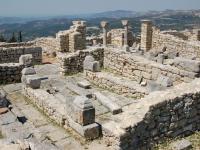Byllis Archaeological Park, Albania (26/01/2013)
Byllis was once the largest city in Southern Illyria and remained an important city during Roman and Byzantine rule in Albania.
Stephanus of Byzantium wrote that Byllis was established by Neoptolemus, Achilles' son, which means it was found around 11th century BC.
Despite this account, existing construction techniques date the site not earlier than 370-350 BC. Around 270 BC. the city was the center of a koinon, a political organization of the time, covering about 20 square kilometers.
Its walls have a length of 2250 meters and cover an area of 30 hectares. In 49-48 BC, the city surrendered the forces of Caesar and served as a base for his large army.
Byllis became a Roman colony during the first years of the dominion of Augustus, and its name became Colonia Iulia Augusta.
During the reign of Emperor Justinian in the 5th century AC, Byllis became an important religious center and several large Palaeo-Christian basilicas were constructed, all of them featuring lavishly decorated mosaics.
Further speaking to its religious significance, the site was awarded a bishopric within the Eastern Orthodox Church. In 586 AC, Byllis was sacked by foreign invaders and was abandoned, never to be inhabited again.
Nowadays, the site features a stunning view of the Vjosë River valley and surrounding mountains.
Visitors can explore the remaining foundations of the original city walls, an amphitheater which originally seated 7,500 and the remains of the basilica.
Source: www.balkansgeotourism.travel
Hours Open: 08:00 – 18:00
Seasons Open: Year-round
Visitor Fees: 300 lek








